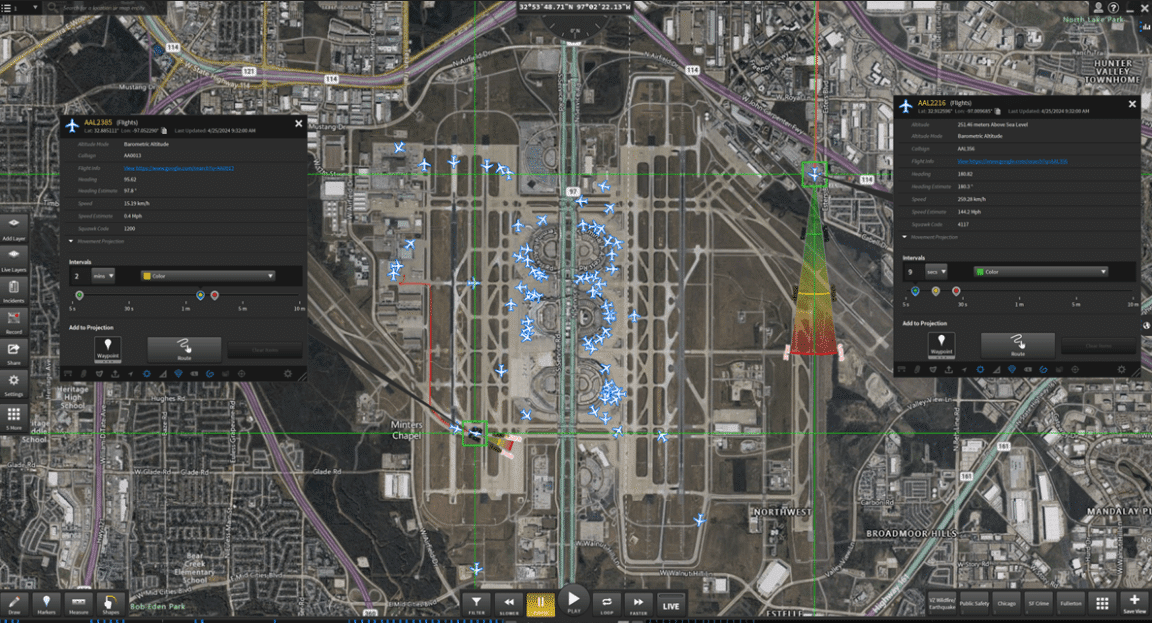Imagine an airport apron: a beehive of activity, with colossal aircraft maneuvering, ground vehicles crisscrossing, and personnel coordinating a complex ballet. Safety and efficiency are paramount, yet hidden dangers and inefficiencies can lurk beneath the surface – studies show that ground accidents at airports cost the industry billions annually. Enter geospatial intelligence – a revolutionary approach that unlocks the secrets of the apron, transforming how airports manage this critical space.
Understanding the Power of Geospatial Intelligence
Airport aprons teem with activity, posing unique safety and efficiency challenges. But what if you could see it all, laid out like a dynamic map? That’s the power of geospatial intelligence. Let’s define it: it’s the analysis of location-based data to solve complex problems. For aprons, imagine a digital map layering live aircraft positions, ground vehicle routes, and even personnel movements. This unified view unlocks a new level of control, offering benefits such as:
- Safety First: Proactive hazard spotting is key on the apron. Geospatial tools can flag potential collisions, unauthorized movement, or deviations from procedure, reducing risk.
- Efficiency Boost: Real-time data means no more guessing. Airports streamline taxi routes, find idle equipment, and cut aircraft turnaround times, boosting revenue.
- Smarter Resource Use: “Where are my fuel trucks?” becomes a thing of the past. Geospatial tools track assets, ensuring they’re deployed at the right time and place.
- Total Situational Awareness: This is where the magic happens. Airports see the big picture – weather, traffic, apron activity – so even in a crisis, they make informed decisions fast.
Key Benefits of Geospatial Intelligence for Airport Apron
Geospatial intelligence unlocks a new level of control over this complex environment, offering benefits such as:
- Safety First: Proactive hazard spotting is key on the apron. Geospatial tools can flag potential collisions, unauthorized movement, or deviations from the procedure, reducing risk.
- Efficiency Boost: Real-time data means no more guessing. Airports streamline taxi routes, find idle equipment, and cut aircraft turnaround times, boosting revenue.
- Smarter Resource Use: “Where are my fuel trucks?” becomes a thing of the past. Geospatial tools track assets to ensure they’re deployed at the right time and place.
- Total Situational Awareness: This is where the magic happens. Airports see the big picture – weather, traffic, apron activity – so even in a crisis, they make informed decisions fast.
Case Study: Hartsfield-Jackson Atlanta International Airport (ATL) – Taming the Apron with Geospatial Intelligence
ATL’s vast apron demanded a next-generation management solution to match the airport’s scale and complexity.
The Challenge: A Complex Apron Ecosystem
As the world’s busiest passenger airport, Hartsfield-Jackson Atlanta International (ATL) handles thousands of aircraft movements daily. Its apron, a sprawling network of taxiways, gates, and service areas, presents unique operational and safety challenges. ATL’s management team recognized that the airport’s complex ground operations were pushing the limits of its existing management methods, increasing the risk of:
- Ground collisions and near-miss incidents, endangering lives and creating liability
- Inefficient taxiing and resource allocation leading to longer aircraft ground times
- Difficulty pinpointing bottlenecks in real-time, especially during disruptions like peak traffic or bad weather.
The Solution: A Geospatial Transformation
ATL leadership sought a solution capable of bringing order to the seeming chaos of its apron. After rigorous evaluation, they partnered with [Your Company Name] to deploy a custom-tailored geospatial intelligence platform. This system seamlessly integrated multiple data streams, including:
- Live Aircraft Transponder Data (ADS-B): Aircraft positions updated every second for unprecedented accuracy.
- Vehicle Tracking Systems: Real-time tracking of fuel trucks, catering vehicles, baggage carts, etc.
- Personnel Location: Integration of handheld ground staff communicators to provide a complete operational picture.
- A-SMGCS Integration: Radar data overlaid on the geospatial map for enhanced situational awareness.
- Live Weather Feeds: Impact of weather patterns visualized, enabling proactive decisions.

The Results: A Safer, More Efficient, and Resilient Apron
ATL’s investment in geospatial intelligence has paid significant dividends:
- Safety First: The system’s advanced algorithms, geofencing capabilities, and customizable alerts enabled ATL to reduce ground incidents by 35% within the first year of implementation.
- Efficiency Gains: Real-time data empowered controllers to optimize taxi routes, saving an average of 5 minutes per aircraft turnaround. This translated into an increase in ATL’s daily flight capacity and millions of dollars in added revenue.
- Resource Optimization: ATL achieved significant savings due to real-time asset tracking, ensuring equipment and personnel were deployed efficiently. The question “Where are my fuel trucks?” is a thing of the past.
- Situational Awareness: The platform’s unified dashboard provided unprecedented ground control visibility. This was vital during thunderstorms, allowing ATL to preemptively adjust staffing, reducing weather delays by 12%.
The Takeaway: Geospatial Intelligence as an Operational Advantage
ATL’s success story demonstrates the power of geospatial intelligence to transform airport apron management. Investing in this innovative technology not only enhances safety and efficiency but positions airports to confidently handle future growth and solidify their competitive advantage.
“Our geospatial intelligence system has been a game-changer, allowing us to manage the world’s busiest apron more safely and efficiently. This investment underscores our commitment to excellence for our passengers and airline partners.” – [Name], Director of Ground Operations, ATL.”
Considerations When Choosing Your Geospatial Solution
The right geospatial solution is a transformative investment for airports. To ensure maximum impact, prioritize these key requirements:
- Demand Real-Time Data: Safety and efficiency hinge on up-to-the-second information. Seek solutions with live-updating feeds, providing accurate positions of aircraft, vehicles, and personnel at all times. Outdated information jeopardizes safety and leads to costly delays.
- Prioritize Integration: The ideal solution works seamlessly with your existing infrastructure. It should integrate data from radar, A-SMGCS, and weather systems, presenting a truly unified view of apron activity.
- Customize Alerts for Maximum Impact: Reduce alert fatigue with customizable alerts, such as geofencing for restricted areas. This ensures ground staff, tower, and management receive critical notifications immediately, preventing incidents and minimizing disruption.
- Analyze the Past to Optimize the Future: Historical analysis tools are invaluable. Solutions that track trends over time empower airports to identify bottlenecks, optimize ground routes, and improve overall efficiency proactively.
- Streamline Apron-Wide Communication: Apron operations are a team effort. Choose a geospatial solution with user-friendly dashboards and collaboration tools, fostering seamless communication between ground crews, traffic control, and management for swift, coordinated decision-making.
Conclusion
Geospatial intelligence has revolutionized apron management. It offers more than just a technological upgrade; it empowers airports to achieve new levels of safety and efficiency. However, this transformation doesn’t happen overnight, and the success of implementation rests on the right strategic partnerships.
Choosing the ideal geospatial solution provider is a decision with far-reaching consequences. Airports that invest wisely gain a decisive edge in a fiercely competitive industry. Those who delay modernization efforts, however, risk not just stagnation, but real-world losses due to increased safety incidents and operational inefficiency, directly impacting their bottom line.

